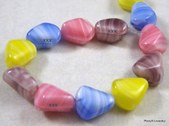
1
Add Description
"Good example of press molded beads s..."
"these mold lines are so prominent ev..."
View Comments...
| 
2
Satin and Moonstone Glass
Satin glass has a satiny, striated appearance, although it is smooth to the touch. It is made by infusing numerous tiny bubbles into the glass while it is still molten. Moonstone glass is made differently, often in layers, and is the most common type of glass used to make star stones. It also has a satiny appearance, without the striations, or sometimes the appearance of moire silk. Although a different type, it is still often called satin glass as well. These types of glass are Czech/Bohemian products exclusively. Catseye glass is usually made from moonstone glass; there are also contemporary Catseye beads made from fiberoptic material. Edit
"I have a blue satin glass necklace t..."
"Satin glass bead are one of my favor..."
"I was able to identify the pink bead..."
View Comments...
| 
3
Add Description
"Moonstone glass"
"Now this is interesting as I never w..."
View Comments...
|

4
Add Description
"Slice beads"
"I had never heard of these beads! Th..."
"These look like multi-colored kernal..."
View Comments...
| 
5
CLICK HERE FOR MORE INFORMATION
Givre Glass
Givre glass is a two toned glass achieved by mixing an opaque glass into a translucent one. The Germans produced more types and colors of givre glass and rhinestones than any other.
Edit
"German givre beads"
"These two toned beads are so pretty...."
View Comments...
| 
6
Add Description
"pretty color"
View Comments...
|

7
Some special categories of glass include:
Leaded glass, called crystal, although glass does not actually have a crystalline structure. Rather, it was made to mimic rock crystal by adding lead to the silica base. Lead greatly increases the refractive index – thus giving it far greater sparkle and also increases the weight. Leaded glass must be at least 24% lead to be called “crystal”; of the types of crystal available, Swarovski has long been the icon, and has more lead than any other crystal made. A note about leaded glass in this health conscious time: It is completely safe, as the lead is tightly bound in the glass structure, and does not wear off or leach out. The Swarovski Co. had to provide a scientific paper to the California government when they outlawed the sale of things containing lead. Edit
"Rare Swarovski turquoise givre cryst..."
"Love the crystals!"
"I love leaded crystal. Leave it to C..."
"Crystal beads are one my favorites. ..."
View Comments...
| 
8
Coatings and Finishes
Glass beads may also be coated with different minerals to change the apparent surface coloring. Of these, the Aurora Borealis coating is best known, and was developed by Daniel Swarovski in 1956, although other similar effects predate this. An oil slick looking coating was used in decorative glassware, called carnival glass, although glass collectors do not apply that term to beads, instead calling it “Irid”, short for iridescent. There are other ways of adding a finish to glass beads, such as a Picasso finish, or acid etching, which gives a matte finish (think of Camphor glass). And the AB coating was just the beginning of after effects coatings developed by Swarovski; other specialty coatings include Vitrail, Heliotrope, Bermuda Blue, Volcano, among many others, and there are now after effects coatings applied to Swarovski beads by other companies. Edit
"Vintage Czech crystal in Madeira Top..."
"I need to learn more abut specialty ..."
View Comments...
| 
9
Add Description
"Uranium glass, sorry, I don;t have a..."
"Be still my heart... I collect Green..."
"Beautiful! Didn't realize they made..."
"I have some uranium trade beads that..."
"I have some Czech pressed glass opaq..."
View Comments...
|

10
Add Description
"Saphiret vs Dragon's Breath (AKA Mex..."
"stunning beads another favorite"
"I agree! Love those saphirets!"
"Beautiful examples, thank you!"
"These are beautful. I can see why pe..."
View Comments...
| 
11
Add Description
"Lace Beads were made by the Venetian..."
"I've never seen these,so delicate an..."
"I agree . . . I don't think I have s..."
"@Mary - They aren't "cut"...."
View Comments...
| 
12
Add Description
"German givre crystal beads."
"Stunning beads! And green, my favori..."
View Comments...
|

13
Add Description
"An Array of foiled opalescent beads:..."
"foiled opalescent . . . I can see th..."
View Comments...
| 
14
CLICK HERE FOR MORE VIEWS Edit
"Venetian foiled Fiorato (Wedding Cak..."
"Seems these Fiorato beads are very p..."
View Comments...
| 
15
Add Description
"Venetian hollow beads - mouth blown ..."
"I like these!"
View Comments...
|

16
Add Description
"High quality Venetian Millifiore bea..."
"Love the darker earth-tone examples...."
View Comments...
| 
17
A Few Words about Venetian beads:
Venice, Italy has long been the home of superior lampworked glass beads, dating as far back as the 9th century. In the late 13th century, the glass makers were all forced to move their operations to one of the many islands that make up Venice – Murano Island, and the name Muranp glass has become synonymous with Italian art glass.
Photos of examples of Piattines, Sommerso, Soffiato, Millifiore, Fiorato, Exposed Foil, Aventurine, and miscellaneous Venetian beads are included. Edit
"An assortment of Venetian Fiorato be..."
View Comments...
| 
18
Add Description
"Venetian Sommerso beads are encased ..."
"I like the star!"
View Comments...
|
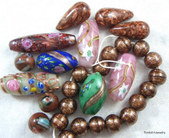
19
Add Description
"Venetian Aventurine beads are made b..."
"Aventurine is so pretty. . . . makes..."
View Comments...
| 
20
CLICK HERE FOR MORE INFORMATION Edit
"Typical Japanese millifiore beads (o..."
View Comments...
| 
21
Add Description
"Japanese dot beads"
View Comments...
|

22
Add Description
"A rare example of press molded Japan..."
"Very unusual! Would make a great pie..."
View Comments...
| 
23
Add Description
"The Japanese excelled at making faux..."
"amazing"
View Comments...
| 
24
Add Description
"Japanese beads resembling Venetian F..."
View Comments...
|

25
CLICK HERE FOR MORE VIEWS Edit
"Czech/Bohemian lampwork sets"
"What beauties!"
View Comments...
| 
26
Add Description
"Vintage necklace made from Satin Gla..."
"One of my favorite beads and wish I ..."
View Comments...
| 
27
Add Description
"Vintage Czech lampwork"
View Comments...
|

28
Add Description
"Vintge Czech/Bohemian necklace with ..."
View Comments...
| 
29
Add Description
"Vintage Czech/Bohemian lampwork"
View Comments...
| 
30
CLICK HERE FOR MORE INFORMATION Edit
"New Czech lampwork"
View Comments...
|

31
CLICK HERE FOR MORE INFORMATION Edit
"Vintage German press molded glass"
View Comments...
| 
32
Add Description
"Vintage German givre fire polished b..."
View Comments...
| 
33
CLICK HERE FOR MORE INFORMATION Edit
"1970's Indian lampwork - notice the ..."
"these are gorgeous love them"
"These are the happiest beads I've ev..."
View Comments...
|

34
CLICK HERE FOR MORE INFORMATION Edit
"New Chinese lampwork, mimicking Vene..."
View Comments...
| 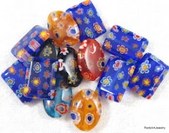
35
Add Description
"New Chinese Millifiore (mosaic glass..."
View Comments...
| 
36
CLICK HERE FOR MORE INFORMATION Edit
"Peking Glass - the real deal"
"I think you should do an Ebay Guide ..."
"Good idea, Barbara."
View Comments...
|

37
Add Description
"Peking glass is made by creating a p..."
View Comments...
| 
38
CLICK HERE FOR MORE INFORMATION Edit
"example of a Picasso finish"
View Comments...
| 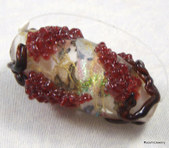
39
Add Description
"example of US lampwork"
"Ok, I have to say I really don't lik..."
View Comments...
|

40
Add Description
| 
41
CLICK HERE FOR MORE INFORMATION Edit
"An array of new Chinese lampwork."
"I see strands and strands of these a..."
View Comments...
| 
42
Add Description
"Hollow blown Chinese beads mimicking..."
View Comments...
|
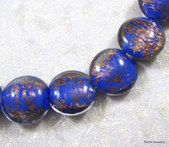
43
Add Description
"New Chinese beads copying Venetian S..."
View Comments...
| 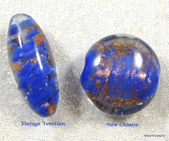
44
Add Description
| 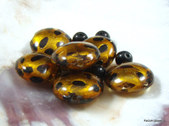
45
Add Description
"New Chinese lampwork - note they are..."
View Comments...
|

46
Add Description
"Foiled lampwork"
View Comments...
| 
47
Add Description
| 
48
BEAD QUIZ Edit
|
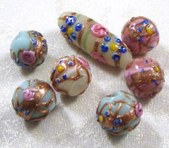
49
Fiorato beads or Wedding Cake if you will...
These are Venetian lampworked beads; what is this type or style of bead called? Edit
""Wedding Cake""
"Pretty Wedding Cake beads, yes."
"Wedding cake beads and they are gorg..."
View Comments...
| 
50
False
Only the Germans ever made givre glass (T or F) Edit
"false"
"False. I read somewhere that there w..."
"False. I think others did them, too."
View Comments...
| 
51
Press Molded
Are these beads press molded or lampworked? Edit
"molded one of my favorite colors in ..."
"I agree..press molded."
"Press molded, a term I learned today..."
"Press molded and lovely"
View Comments...
|

52
Japanese Millifiore (Mosaic) glass
What are these beads? Where are they from? Edit
"Japanese millifiore beads Susan @Eur..."
"Definitely Japanese millifiore. Some..."
"Millefiori beads from Japan"
"Are they millifore? Not sure where t..."
View Comments...
| 
53
False
Foiled lampworked glass beads have only ever been made by the Venetians. (T or F) Edit
"false"
"false"
"False"
"False"
"False"
"not true"
View Comments...
| 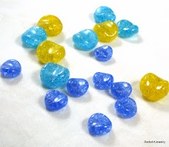
54
False...These are German crackle glass
These are classic 1970's era Indian lampworked beads. (T or F) Edit
"true"
"true"
"True"
"True I guess; impurities"
"not sure on this one"
View Comments...
|
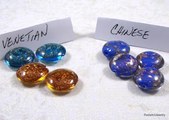
55
False
Only the Venetians burn the bead release (or kiln wash) from the bead holes. (T or F) Edit
"false"
"false"
"false"
"False"
"false"
"false"
"False"
"False. The Chinese do it too"
"False - the Chinese are doing it now..."
View Comments...
| 
56
False
These are typical Japanese beads. (T or F) Edit
"false"
"false"
"False"
"False; they're Chinese"
"False - I got burned on a humongous ..."
"They don't look Japanese to me!"
View Comments...
| |